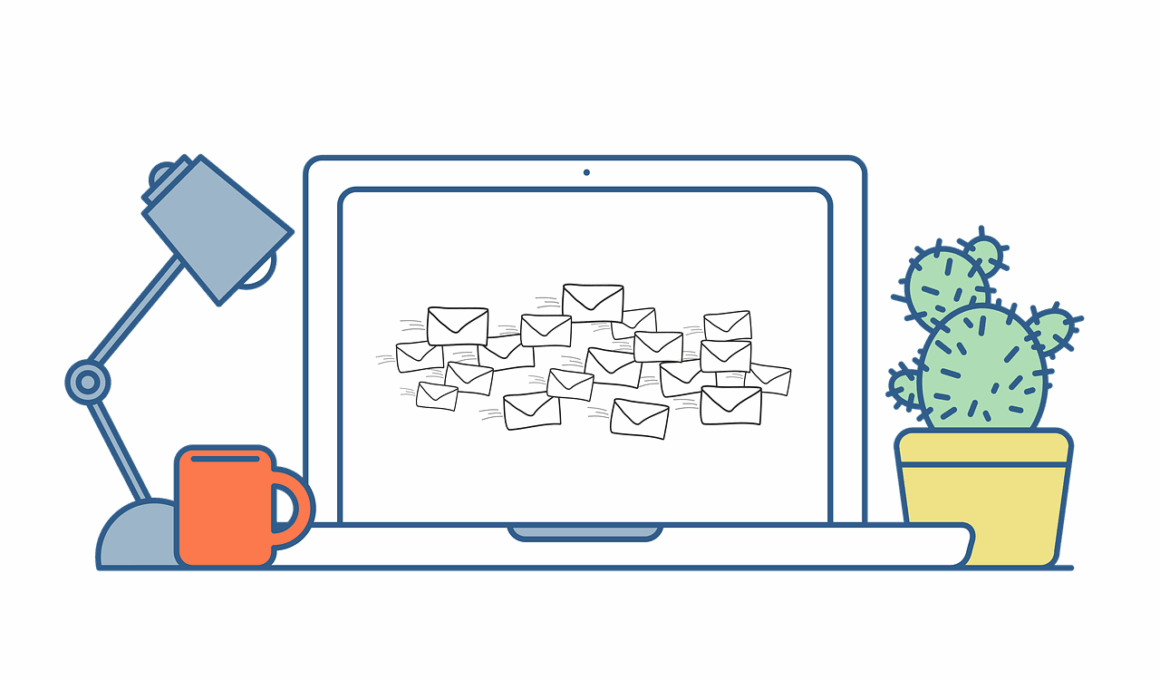Re-engagement Campaigns: Winning Back Inactive Subscribers
Re-engagement campaigns are vital strategies in email marketing for reviving inactive subscribers. These individuals, once enthusiastic, may have drifted away due to various reasons. Understanding why subscribers become inactive is critical for the design of effective campaigns. Factors can include changes in interests, overwhelming email frequency, or irrelevant content. To successfully win them back, it is essential to analyze past interactions and assess what may have lost their interest. By segmenting your audience based on their previous behaviors and preferences, tailored approaches can significantly enhance the chances of reactivation. Personalization plays a key role in these efforts. Sending customized emails that address subscribers by name and include content relevant to their past interactions encourages engagement. Additionally, offering exclusive discounts or valuable information can incentivize their return. Implementing attention-grabbing subject lines is crucial. These should evoke curiosity or underscore benefits, making it difficult for recipients to ignore your emails. A compelling subject line is often the difference between opening your email and ignoring it. Balancing frequency and content quality will keep your brand present without overwhelming subscribers into further disengagement.
Another effective technique involves utilizing surveys to understand subscriber sentiments. By actively soliciting feedback, you can identify areas that need improvement and show that you value their opinions. Including a brief survey link within your re-engagement emails captures responses on their preferences. This not only aids in updating your email strategy but also helps remind subscribers that their insights matter. Too often, brands overlook the importance of listening, leading to lost opportunities. In addition to surveys, testing varied content formats can also spark interest. Video content or infographics may resonate more than plain text for some audiences. By diversifying your email content, you can find what resonates best with previously disengaged subscribers. This variety can help re-establish connections that may have been severed. Furthermore, using behavioral triggers can guide your re-engagement strategy. For example, if a subscriber browses your website without making a purchase, sending a follow-up email can be a gentle nudge to reignite their interest. Such timely communications demonstrate attentiveness to their behavior. Ultimately, a multi-faceted approach combining feedback, content diversity, and behavioral insights can steadily rebuild subscriber loyalty.
Creating Compelling Offers to Re-engage
When planning your re-engagement campaign, crafting appealing offers is crucial. Discounts, free trials, or exclusive content may entice inactive subscribers back to your fold. It’s essential to highlight the value of these offers prominently in your emails. Subscribers need clear reasoning as to why they should re-engage with your brand. For instance, if providing a discount, ensure it is substantial enough to spark interest. Communicate clearly how this offer can benefit them in a way they might have overlooked previously. Unique promotions tailored to their interests can also hold significant persuasive power. By analyzing their previous purchases or interactions, you can create offers that feel personally curated. Visual elements, such as eye-catching graphics or bright call-to-action buttons, amplify the effectiveness of these offers, ensuring they stand out in crowded inboxes. Furthermore, maintaining urgency in your communication can prompt quicker action. Phrasing your offers as limited-time deals encourages recipients to act sooner rather than later. Communicating such urgency effectively conveys that these special terms are not always available. An engaging offer sends the message that the brand recognizes their past value and is eager to nurture that relationship again.
Another aspect of successful re-engagement campaigns lies in designing strategic follow-up sequences. Initial emails may not always yield immediate results, so it is essential to plan an automated series based on specific triggers. Each follow-up should build on the previous interaction, gradually revealing new benefits and offers. This systematic approach keeps your brand at the forefront of the subscriber’s mind without overwhelming them with too much information at once. This method allows you to maintain relevancy throughout efforts, adjusting based on engagement signals. Analyze which emails or offers received better responses to refine your future campaigns. Dynamic content can also be a useful tool in this area. Adapting email content to reflect the preferences or behaviors of the recipient can significantly enhance personal relevance. This could range from changing visuals to tailoring product recommendations seen in the email. With each interaction, aim to foster a connection that showcases understanding and responsiveness to their needs. Treat each email as an opportunity to deepen the relationship, rather than just another marketing attempt. By consistently providing value, you cultivate a foundation that makes re-engagement campaigns more successful.
Measuring Success and Making Adjustments
After implementing your re-engagement campaign, it is crucial to measure its effectiveness. Monitoring key performance indicators (KPIs) enables you to assess the impact of your strategies and identify areas for improvement. Essential KPIs might include open rates, click-through rates, and conversion rates. Each of these metrics reveals intricate details about how your subscribers are responding to your emails. Don’t shy away from adjusting your approach based on these results. If a certain subject line consistently yields low open rates, explore different phrasing or create A/B tests for better insights. Additionally, understanding subscriber demographics can lead to more tailored follow-ups that reflect their interests. It’s crucial to view these campaigns as ongoing processes, not just one-time efforts. Regular reviews will ensure your strategies remain relevant and effective. Addressing changing subscriber needs and preferences over time is imperative for sustained success. Given the dynamic nature of consumer behavior, staying ahead of trends through regular analysis fosters an adaptive marketing strategy. This proactive approach will have meaningful impacts, leading to rekindled interest and, ultimately, increased brand loyalty.
Moreover, consider giving your subscribers a consistent re-engagement touchpoint, such as a monthly newsletter. Utilizing regular communication allows you to keep your brand fresh in their minds without imposing sales pitches. Sharing valuable content, company news, or customer stories helps maintain an ongoing relationship. A well-crafted newsletter should prioritize content quality over sales volume, fostering genuine connections with subscribers. As subscribers begin to recognize your emails as a reliable source of information, their trust in your brand will grow, making them more likely to engage further. Additionally, incorporating audience polls within newsletters can offer insights while making subscribers feel that their voices matter. Creating a sense of community is another important aspect of effective email marketing. You can empower subscribers by inviting them to interact, share experiences, or provide feedback. Personal stories or testimonials can also enrich your newsletters, making them relatable. Engaging emails strengthen connections, as subscribers are more likely to open subsequent messages from a brand that consistently provides valuable content. This strategy not only enhances engagement rates but also works well in fostering loyalty and a positive brand perception.
Long-term Relationship Building with Subscribers
Ultimately, the goal of re-engagement campaigns extends beyond immediate actions. Building long-lasting relationships hinges on regular engagement, transparency, and authenticity. By showing a genuine interest in your subscribers, you can transform one-time buyers or casual browsers into loyal advocates. Being transparent about your objectives, campaigns, or changes builds trust and fortifies the relationship. Subscribers are more likely to connect emotionally with brands that resonate authentically with them. It’s crucial to value your subscribers not just as consumers but as individuals possessing preferences and interests. Regularly communicating genuine appreciation for their engagement will enhance this bond. Consider segmenting your communication approach according to their past interactions, ensuring targeted communication truly resonates. As segments evolve, continue to adapt your strategies based on real-time engagement data. Remember, re-engagement is not merely a one-off effort; it’s a continuous journey that improves over time. Keeping the focus on nurturing these relationships is essential. In a crowded marketplace, showcasing your commitment can lead to significant differentiation from competitors, reinforcing the loyalty that your re-engagement campaigns originally sought to ignite.
Re-engagement campaigns provide invaluable learning opportunities and insights into subscriber behaviors and preferences. Utilizing the knowledge gained from these campaigns can shape overall marketing strategy moving forward. Always be ready to refine and redefine aspects of your email strategy. Subscriber evolution is a natural process; understanding their journey allows for more targeted practices. Nurturing relationships with each touchpoint enriches their experience, promoting brand loyalty. Moreover, consider employing a combination of digital marketing methods to complement re-engagement efforts. Integrating social media interactions, retargeting ads, and personalized website experiences provides a holistic view of customer engagement. Maintaining a cohesive approach among multiple channels can enhance overall effectiveness. Addressing subscriber inactivity is critical for sustaining a healthy email list and promoting brand growth. Brands must prioritize fostering relationships through meaningful, relevant, and timely communications. Paying attention to subscribers’ changing needs not only brings them back but keeps them engaged over time. Investing in relationships with subscribers is always worth the effort. Remarketing efforts can pave the way towards deeper connections, ultimately leading to greater lifetime value. Staying proactive in managing these relationships contributes significantly to your email marketing success.


